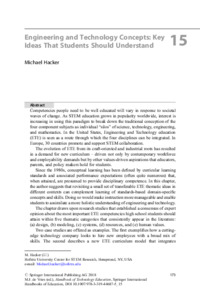Engineering and Technology Concepts: Key Ideas That Students Should UnderstandMichael Hacker
|
 |
 Diese Seite wurde seit 1 Jahr inhaltlich nicht mehr aktualisiert.
Unter Umständen ist sie nicht mehr aktuell.
Diese Seite wurde seit 1 Jahr inhaltlich nicht mehr aktualisiert.
Unter Umständen ist sie nicht mehr aktuell.
 Zusammenfassungen
Zusammenfassungen
 Competencies people need to be well educated will vary in response to societal waves of change. As STEM education grows in popularity worldwide, interest is increasing in using this paradigm to break down the traditional conception of the four component subjects as individual 'silos†of science, technology, engineering, and mathematics. In the United States, Engineering and Technology education (ETE) is seen as a route through which the four disciplines can be integrated. In Europe, 30 countries promote and support STEM collaboration.
Competencies people need to be well educated will vary in response to societal waves of change. As STEM education grows in popularity worldwide, interest is increasing in using this paradigm to break down the traditional conception of the four component subjects as individual 'silos†of science, technology, engineering, and mathematics. In the United States, Engineering and Technology education (ETE) is seen as a route through which the four disciplines can be integrated. In Europe, 30 countries promote and support STEM collaboration.The evolution of ETE from its craft-oriented and industrial roots has resulted in a demand for new curriculum - driven not only by contemporary workforce and employability demands but by other values-driven aspirations that educators, parents, and policy makers hold for students.
Since the 1980s, conceptual learning has been defined by curricular learning standards and associated performance expectations (often quite numerous) that, when attained, are presumed to provide disciplinary competence. In this chapter, the author suggests that revisiting a small set of transferable ETE thematic ideas in different contexts can complement learning of standards-based domain-specific concepts and skills. Doing so would make instruction more manageable and enable students to assimilate a more holistic understanding of engineering and technology.
The chapter draws upon research studies that established a consensus of expert opinion about the most important ETE competencies high school students should attain within five thematic categories that consistently appear in the literature: (a) design, (b) modeling, (c) systems, (d) resources, and (e) human values.
Two case studies are offered as examples. The first exemplifies how a cutting-edge technology company looks to hire new employees with a broad mix of skills. The second describes a new ETE curriculum model that integrates important concepts within authentic social contexts and supports the fundamental purposes of education.
 Dieses Kapitel erwähnt ...
Dieses Kapitel erwähnt ...
 Personen KB IB clear | Margaret L. Hilton , James W. Pellegrino | ||||||||||||||||||
 Begriffe KB IB clear |  Mathematik Mathematik mathematics
, mathematics
,  MINT MINT science, technology, engineering, mathematics
, Palantir
, Paradigmaparadigm science, technology, engineering, mathematics
, Palantir
, Paradigmaparadigm
| ||||||||||||||||||
 Bücher |
|
 Zitationsgraph (Beta-Test mit vis.js)
Zitationsgraph (Beta-Test mit vis.js)
 Anderswo finden
Anderswo finden
 Volltext dieses Dokuments
Volltext dieses Dokuments
 |  Engineering and Technology Concepts: Key Ideas That Students Should Understand: Artikel als Volltext bei Springerlink ( Engineering and Technology Concepts: Key Ideas That Students Should Understand: Artikel als Volltext bei Springerlink ( : :  , 380 kByte; , 380 kByte;  : :  ) ) |
 Anderswo suchen
Anderswo suchen 
 Beat und dieses Kapitel
Beat und dieses Kapitel
Beat hat Dieses Kapitel während seiner Zeit am Institut für Medien und Schule (IMS) ins Biblionetz aufgenommen. Beat besitzt kein physisches, aber ein digitales Exemplar. Eine digitale Version ist auf dem Internet verfügbar (s.o.). Aufgrund der wenigen Einträge im Biblionetz scheint er es nicht wirklich gelesen zu haben. Es gibt bisher auch nur wenige Objekte im Biblionetz, die dieses Werk zitieren.









 Biblionetz-History
Biblionetz-History